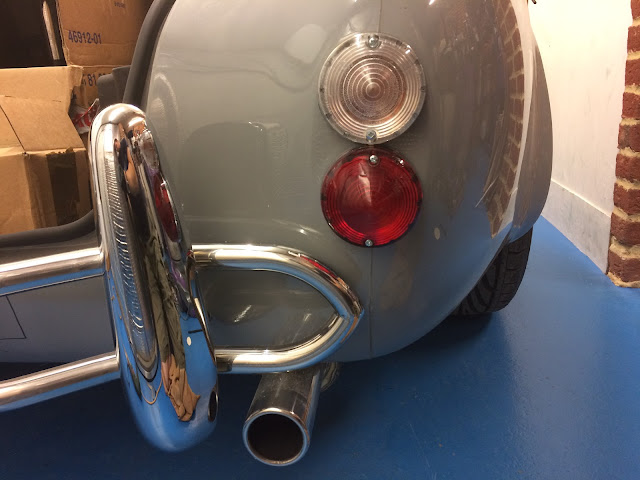Hurray! My shoulder is getting better. It's not perfect yet but I'm able to start some less demanding tasks.
So on to finishing off the hot air management part of the heater.
The AK bodyshell comes with a fibreglass plenum for the heater matrix.
This requires drilling and pipe fitting to feed ductwork which will lead hot air to the screen demist vents.
I'm choosing to also to provide heat for both the driver and passenger footwells too as the polo heater has plenty of grunt.
So using standard waste outlet pipe I've marked up the top of the plenum for drilling.
And a trial hole and test proves the interference fit I was lookin for - a small rap with a rubber mallet and this is held strongly.
With combined silicone adhesive sealant compound this should hold firm and be air tight too.
So with 4 holes drilled time for a quick check and mark up for where the adhesive will go to seal.
It's been a while since my trainers have made an appearance in the photos so thought I'd include the one above.
4 pipe outlets temporarily fitted.
Dr Who monster creators will be calling me up to help them with their next creation after they've seen the below.
I've decided to seal the hoses onto the outlets first before sealing it onto the body tub as the hose is a tight fit and it's easier to do now. The hose clips will eventually be removed.
Final preparation of the heater matrix above with making a foam insert and gluing that in position too.
Note the holes either side of the matrix. I've made small brackets which will hold the plenum in place whilst sealing on.
Thankfully this will be hidden from view so the sealing has been thorough.
The last piece of this puzzle was to join the heater motor wires to longer pieces and feed through back into the cabin where they can be connected to an appropriate switch and fuse config.
Where cables come through the body they must be protected. Being a fan of doing the job properly (because chafing wires eventually make fires - you heard it here first!) I've chose to grommet the hole and feed conduit through too. The fan wires are inside the convoluted tube.
(The other grommet hole is for the reverse light and neutral/park safety switch wires which come from the gear selector - ran them under the tub as I didn't want to have them running on top of the transmission tunnel as can be seen below)
I fired the engine up once this this was all set. The good news is hot air is plentiful.
The bad news is that the fan motor is squealing on medium and high speed. Which is a bit of a pain as it was fine when I tested it out of the car.
On to the desnagging list it goes :-(



















































